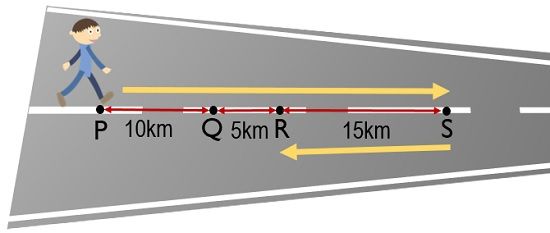Distance and Displacement are the two major terms of concern when we consider path length while travelling from one point to another. The crucial difference between distance and displacement is that distance is a scalar quantity thus shows concern only with magnitude. As against displacement is a vector unit that is concerned with both magnitude and direction of a moving body.
So distance provides the information regarding the actual complete length of the path between two locations irrespective of the direction. While displacement shows the final location of a moving body in a particular direction.
Content: Distance Vs Displacement
Comparison Chart
| Basis for Comparison | Distance | Displacement |
|---|---|---|
| Definition | The overall path length between two points is known as distance. | Displacement is regarded as shortest possible distance between two locations. |
| Type of quantity | Scalar | Vector |
| Dependency | Path dependent | Position Dependent |
| Denoted as | d | s |
| Given as | d = speed * time | s = velocity * time |
| Value | Always positive | It can be either positive, negative or zero. |
| Informs about | Actual complete path length. | Shortest path between the point of beginning and the destination. |
| Possible value magnitude | The magnitude of distance will always be either equal or more than displacement. | The magnitude of displacement will always either equal or lesser than distance. |
Definition of Distance
The term distance defines the actual length of the path between two points without the consideration of the direction. Consider the figure given below:
Suppose a body is present at point P, it starts moving from that particular point and reaches Q. After some time it again starts moving and reaches R. Now, immediately it proceeds towards the next point S. Now from S, the body turns back, starts moving and stops at R.
The length between every two separate points is given in the above figure. So, the actual path travelled by the body will be its distance.
Hence it will be given as:
PR = PQ + QR + RS + SR
PR = 10 km + 5 km+ 15 km + 15 km
PR = 45 km
Thus the overall distance travelled by the body will be 45km.
By observing this we can clearly say that the direction of movement does not put any impact on the magnitude of distance. Though the body travels in a reverse direction after reaching S to reach R, while finding the distance the complete path travelled by the body is taken into consideration.
Definition of Displacement
Displacement is defined as the overall change in the position of a body while moving from one place to another. Displacement is compulsorily concerned with the shortest route between two locations.
Let us consider the above figure again:
In the previous case, we have determined the overall distance travelled by the moving body. Now we have to find the displacement of the body. So as we have considered that the body begins to move from point P, reaches S and turns back to stop at R.
Thus the displacement of the body will be considered as path length between the initial and final position of the body, on considering the shortest path. So for this particular case, the displacement of the body will be given as:
PR = PQ + QR
PR = 10 km + 5 km
PR = 15 km
So, 20 km is the displacement of the body.
Here as we have seen that though the body first approaches S, its final destination is R because it moved in a reverse direction. Thus we say that displacement of the body is concerned with both magnitude as well as direction.
Key Differences Between Distance and Displacement
- Distance is the measure of the overall actual path length between two points. Whereas displacement is the measure of the shortest path between two points.
- Distance is path-dependent. However, displacement is position-dependent because its value depends on the initial and final position of the moving body.
- Due to scalar nature, distance is only concerned about the magnitude and not the travelling direction. As against due to vector nature the value of magnitude is the combined outcome of the path travelled and direction of movement.
- Distance can never be either negative or zero, thus it is compulsorily a positive quantity. While displacement is can be either positive, negative or zero depending upon the direction of movement.
- Distance is generally denoted as ‘d’ while displacement as ‘s’.
- Distance is given as the product of the speed of the moving object and time taken by it. While displacement is the product of moving velocity and time taken.
- Another important factor that differentiates the two is that value concerning distance will always be either equal or more than displacement. While the magnitude of displacement is either lesser or equal to that of the distance.
Conclusion
Thus from this discussion, we can conclude that the calculated displacement may or may not be equal to the length of the path actually being traversed by the moving object.

